Consumer Survey: The State of Waiting in Line (2023)
Customer satisfaction and patience are on the decline. In an effort to surface tactical solutions for businesses, Waitwhile surveyed 1000 U.S. consumers to better understand how their expectations are shifting and where they stand when it comes to standing in line.
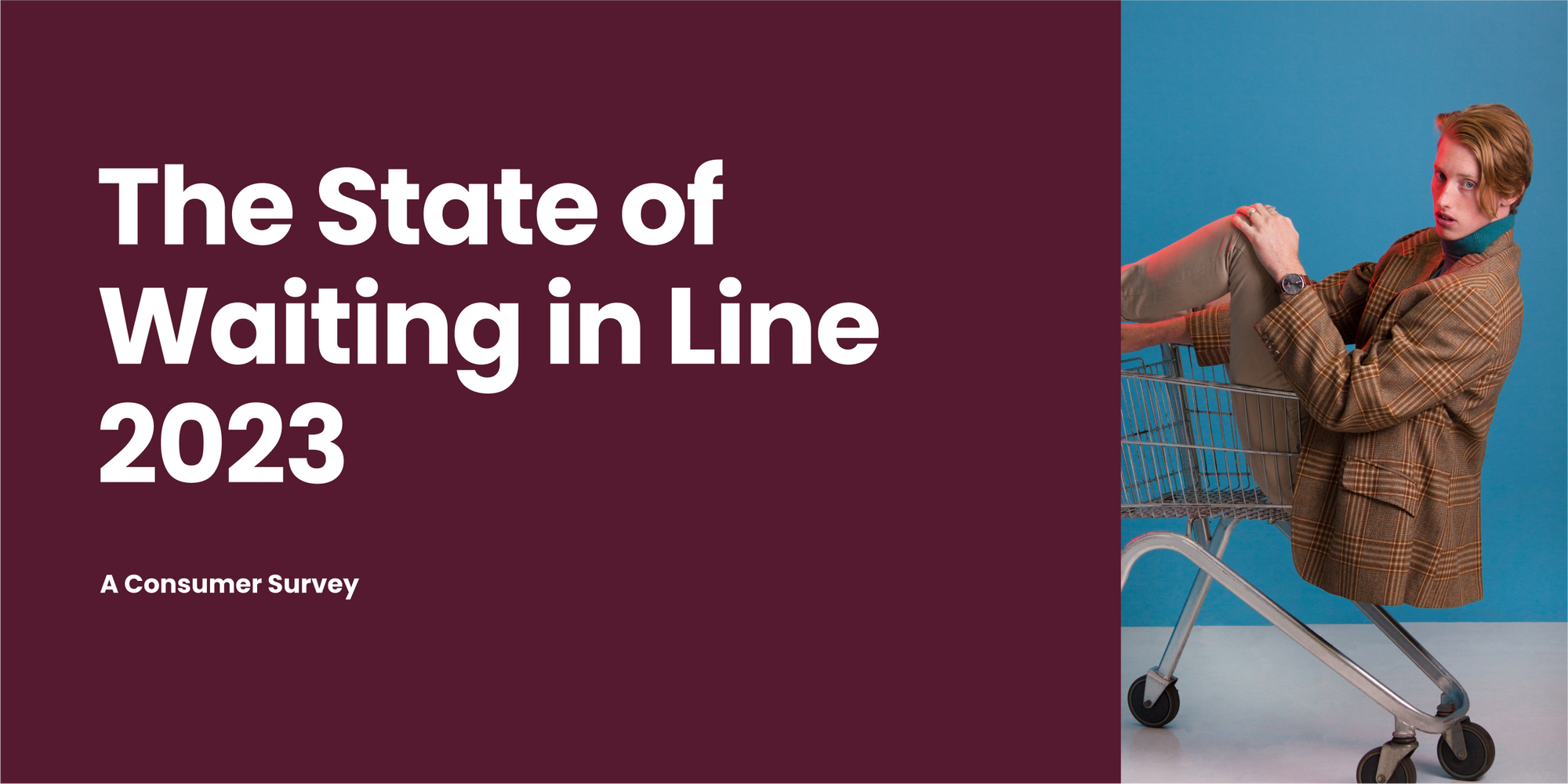
This post summarizes the findings from Waitwhile’s The State of Waiting in Line (2023), a study that explores how frequently consumers are waiting in line, how they feel about waiting, and how brands can improve their queue management. To access the full report or download a copy, click here.
In last year’s first-ever edition of Waitwhile’s The State of Waiting in Line, we sought out to better understand how consumers feel about the storied pain of physical queuing, which has been called a “timeless form of torture.” In the U.S. alone, Americans spend roughly 37 billion hours each year waiting in line.
Our 2022 survey was definitive in its findings: people really don’t like waiting in line. We found that almost 70% of consumers associated waiting in line with negative feelings like boredom, annoyance, frustration, and impatience. And though the vast majority of consumers said they prefer virtual queues to physical lines, Waitwhile’s survey found poor adoption of digital queue management solutions by businesses. Only 15% of consumers said they were able to wait virtually the last time they encountered a line.
We’ve made great progress as a society in eliminating daily inconveniences with inventive solutions and advancements in technology. But when it comes to the hassle of waiting in line, consumers remain frustrated by a lack of convenience.
As you’ll see in the findings, having to wait in line is still a major pain point for today’s consumer, and it’s an aggravation that is being exacerbated by a number of factors that are testing human patience. Much has been written about how technology is ruining our patience by rewiring our brains to expect a cycle of instant gratification – one that consistently (and quickly) rewards our psyches with content, items, and services. In 2015, Microsoft found that the human attention span was shorter than that of a goldfish. Studies since have shown that our ability to focus is shrinking further year by year.
This observed phenomenon of dwindling patience comes at a particularly challenging time. Though the COVID-19 pandemic is no longer a global health emergency, its impacts on mental health are serious – and ongoing. Anxiety and uncertainty (especially when it comes to the economy) not only continue to plague consumers, but are actually both at all-time high levels. We’re operating with shorter fuses and even normally calm people are having a hard time handling their emotions.
There are real consequences for businesses. The double-whammy of thinning consumer patience and historic anxiety has led to a rise in reported incivility, with consumer-facing frontline employees bearing the brunt of the burden. 78% of employees believe that bad behavior from customers is more common now than it was 5 years ago, according to research published in Harvard Business Review. As a result, businesses across retail, hospitality, and food services are experiencing a major workforce crisis, with quit rates in those industries significantly outpacing the national average.
Inaction on declining customer satisfaction – especially when it comes to the problem of waiting in line – is no longer tenable. Businesses need to revamp their approaches to queue management to meet the needs of the modern consumer. In an effort to surface tactical solutions for businesses, Waitwhile surveyed 1000 U.S. consumers to better understand how their expectations are shifting and where they stand when it comes to standing in line.
Part 1: Waiting and Impatience
Waiting in line is 3X more common in retail
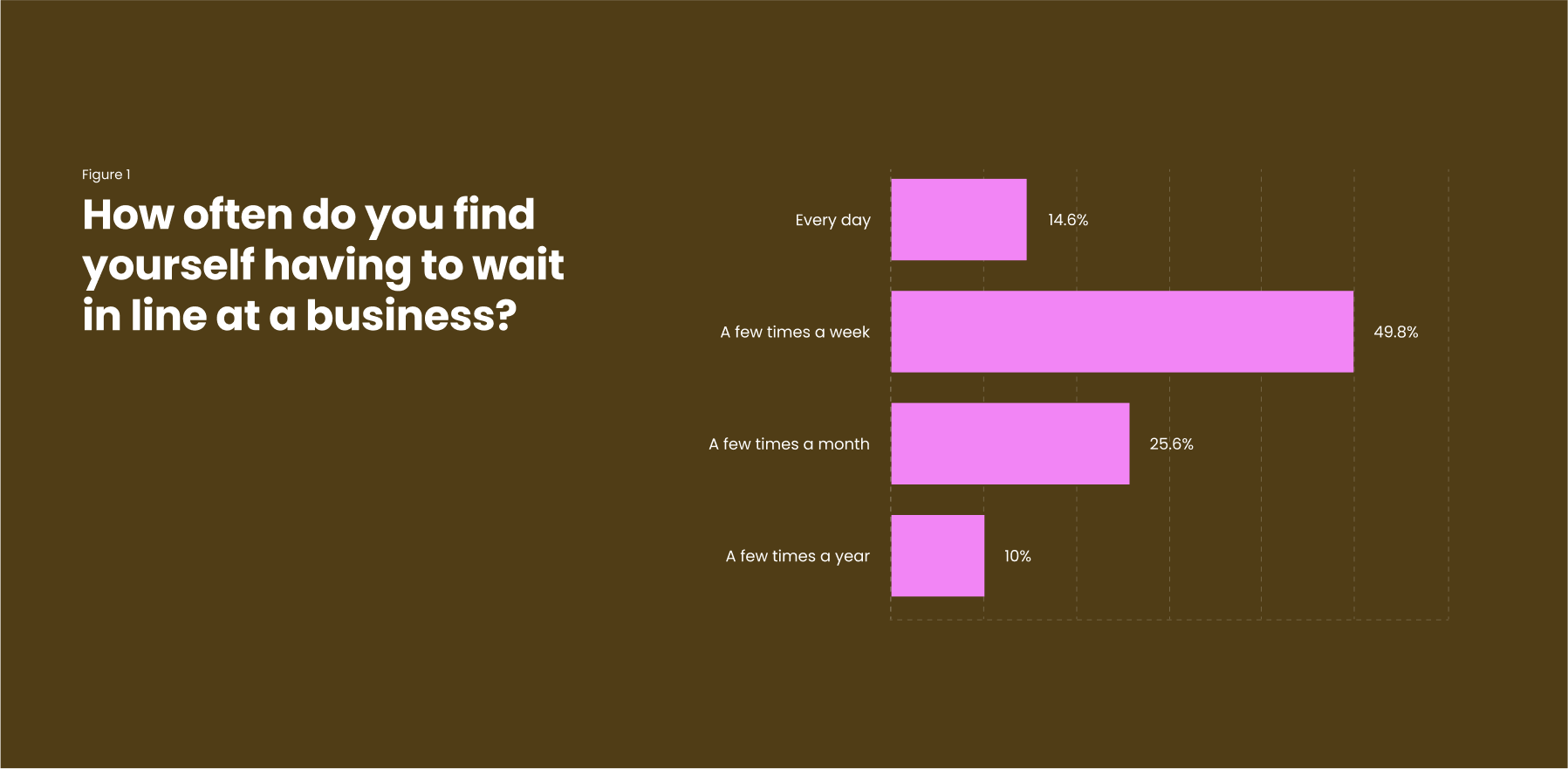
Having to wait in line is a pervasive problem. 90% of consumers report having to wait in line at least a few times a month. 64% of consumers say they have to wait in line multiple times a week (Figure 1).
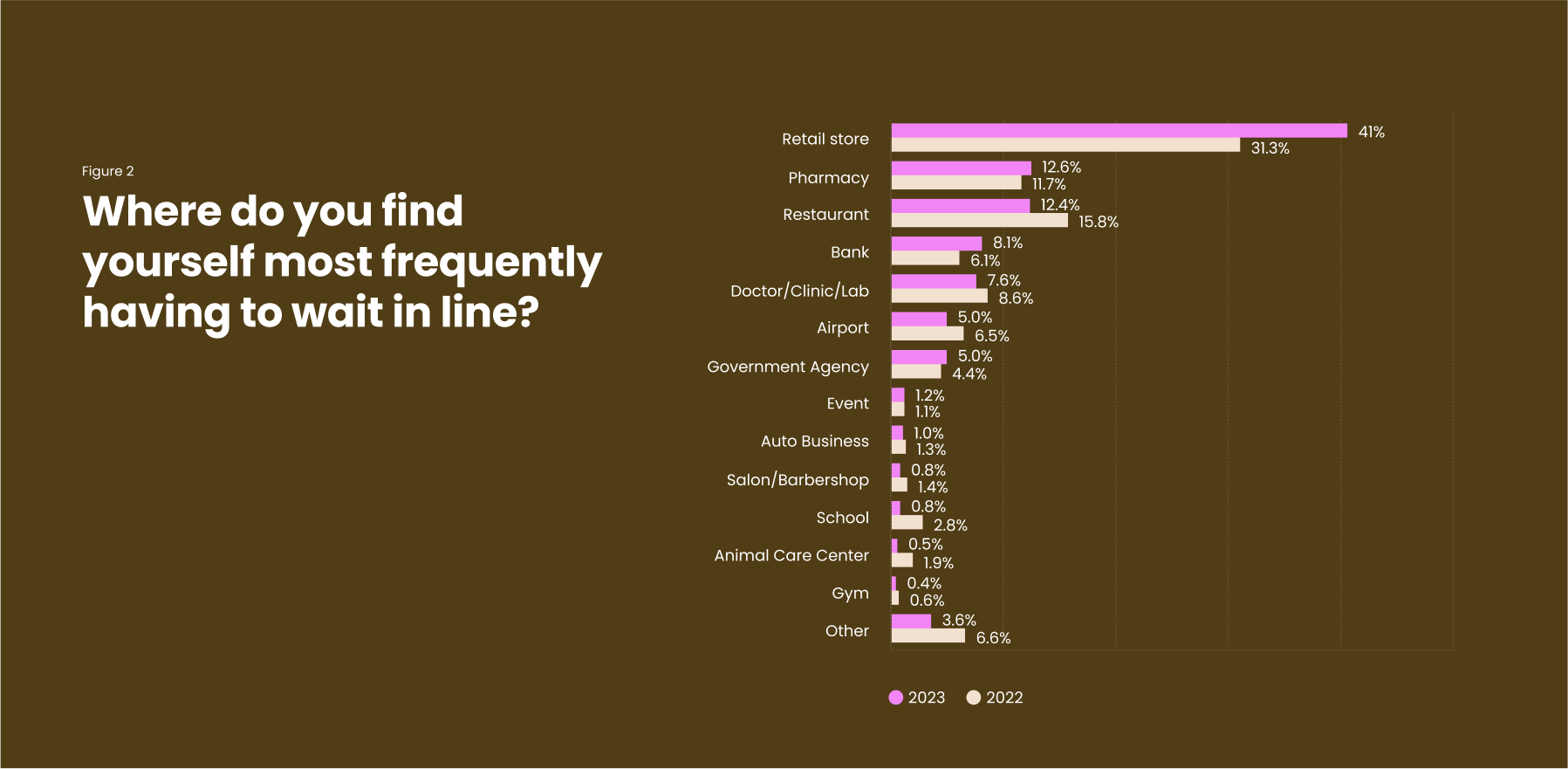
According to consumers, the retail industry is the worst offender. Americans spend more time waiting in line at retail stores than at restaurants, pharmacies, doctor’s offices, and banks combined (Figure 2). This marks the second year in a row that retail is the top industry where consumers regularly encounter lines. Notably, the time spent waiting in line at retail stores has increased by 30% since 2022.
Retailers are clearly still struggling to keep up with sustained consumer demand for physical shopping experiences. After pandemic isolation, consumers flocked back to brick-and-mortar in search of immediate connection with the brands and products they love – and these shopping behaviors show no signs of waning.
Yet, retailers are dealing with a workforce crisis. High employee turnover rate in retail isn’t new, but replacing frontline workers has never been harder. Needing to operate with fewer staff, retail businesses must adopt virtual queue management solutions that can significantly cut wait times or eliminate lines altogether.
Related: Customer Flow Management Checklist for Retail
Consumer impatience rose by 176% YoY

The vast majority of consumers still associate waiting in line with negative emotions. Nearly 67% of the consumers surveyed here report feeling impatient, bored, annoyed, frustrated, or disrespected when they have to wait.
Notably, impatience skyrocketed this year – increasing by 176% – even as negative emotions have remained relatively stable YoY (67% this year vs. 69% in 2022). This suggests that consumers are shifting from boredom and annoyance towards impatience.
Our reliance on tech and society’s immersion in the digital world have had significant impacts on human psychology. Studies have shown that the meaning of “instant” (as in “instant gratification”) is shifting as we become more accustomed to getting what we want faster. According to The Conversation, “this ultimately sets up challenging, and sometimes unrealistic, expectations of those who are trying to serve us.”
Higher impatience is contributing to greater consumer incivility. Waitwhile’s Employee Sentiment Report: Retail, published earlier this year, found that 68.5% of retail workers regularly deal with frustrated or angry customers –- and that long wait times were the top cause of customer frustration according to frontline employees. Additionally, 73% of retail employees said that long lines or long waits are a persistent problem at work.
Time is quite literally running out for businesses to rethink their approaches to how they manage their lines. With both consumer impatience and frontline employee unhappiness on the rise, businesses across all industries need to reinvigorate their queue management process with innovative tech.
57% of consumers feel like waiting in line is a waste of time

More than half of consumers say that waiting in line is a waste of time (Figure 4). Even though this finding is unsurprising given the high levels of impatience, boredom, frustration, and annoyance associated with queuing (Figure 3), it’s concerning when it comes to customer experience. A majority of consumers associate lines with a loss of time, which likely negatively impacts overall satisfaction.

This survey found that consumers are eager for alternatives. Almost 70% of respondents said that they would prefer to schedule an appointment rather than wait in line (Figure 5). Businesses that offer easy appointment scheduling are likely to see positive impacts to customer satisfaction. This solution would also benefit frontline staff by reducing negative customer interactions.
Part 2: The Impacts on Business
44% of consumers are less satisfied with businesses that have lines
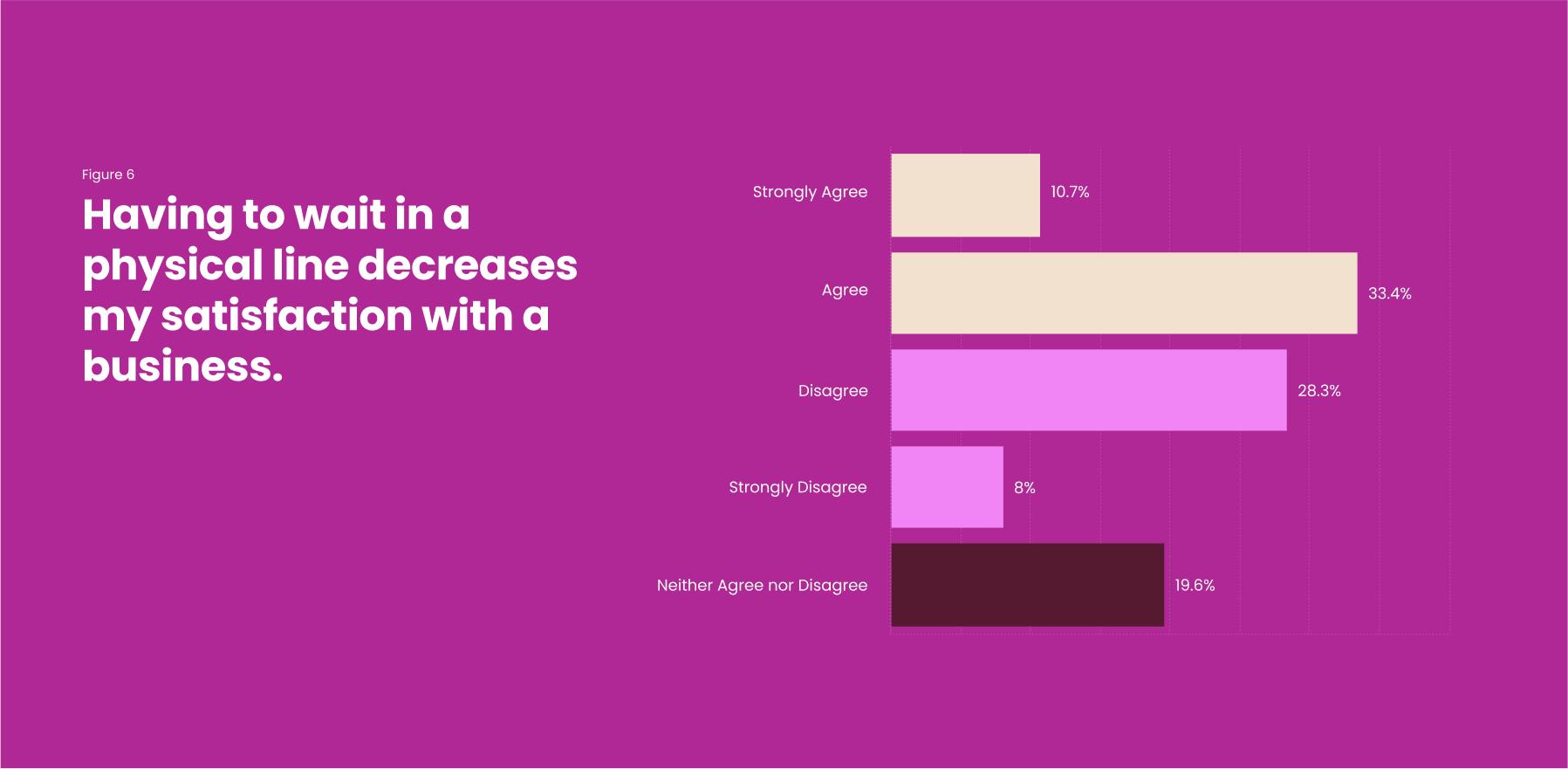
Lines have real impacts on business. Almost half of the consumers surveyed said that waiting in a physical line decreases their satisfaction with a business (Figure 6).
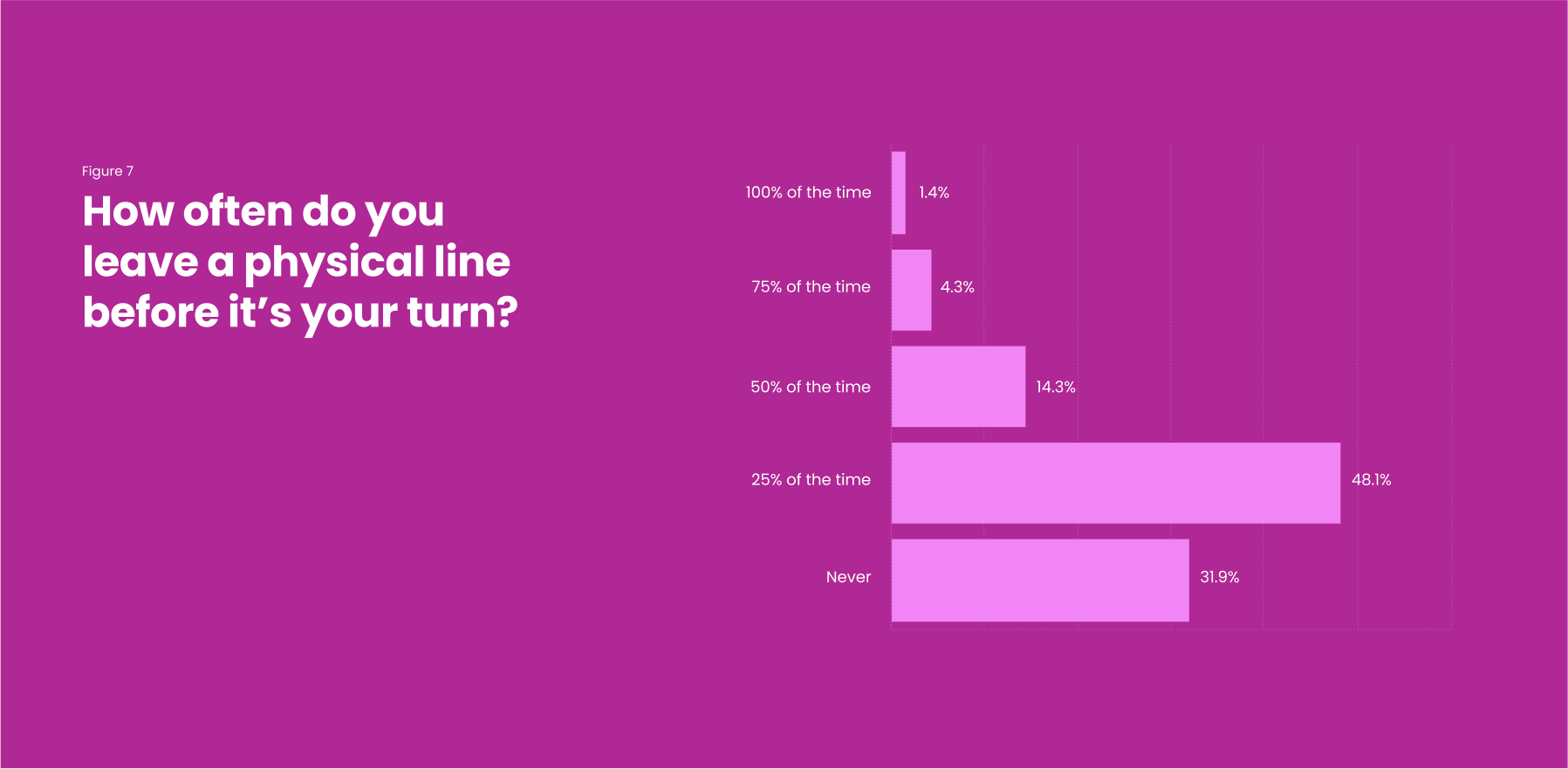
Critically, physical lines are associated with decreased customer throughput. More than 68% of consumers said they leave a physical line before it’s their turn. Almost 1 in 5 leave a physical line more than 50% of the time. That’s business walking out the door (Figure 7).
Physical lines are clearly associated with negative business outcomes, which we explore further in the following figures.
Related: How to Reduce Wait Times & Increase Customer Satisfaction
82% of consumers avoid going to a business because of lines
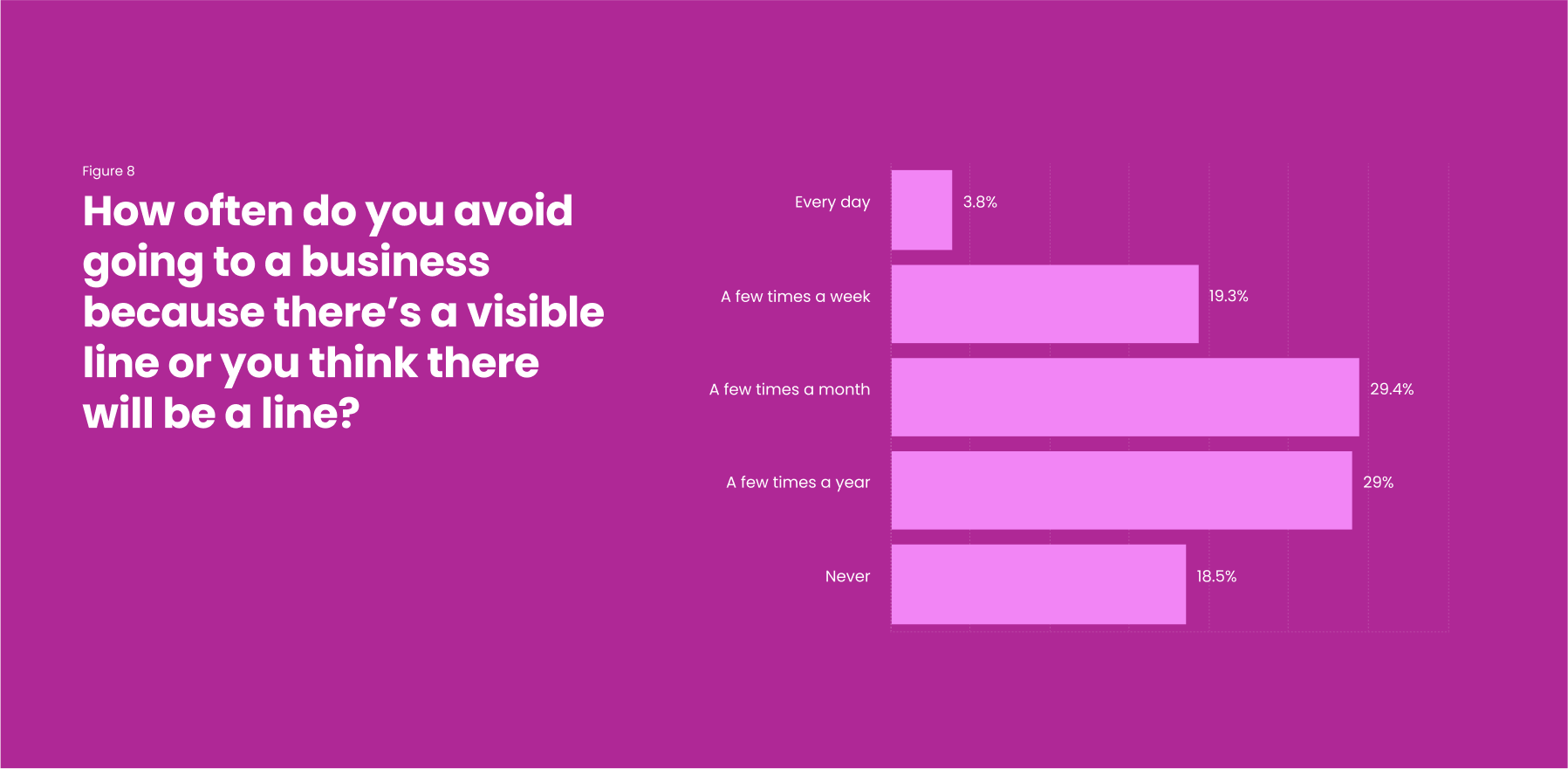
Consumers really don’t like waiting in line. A vast majority of consumers (82%) actively avoid going to businesses because there’s a visible line or because they think there will be a line (Figure 8).
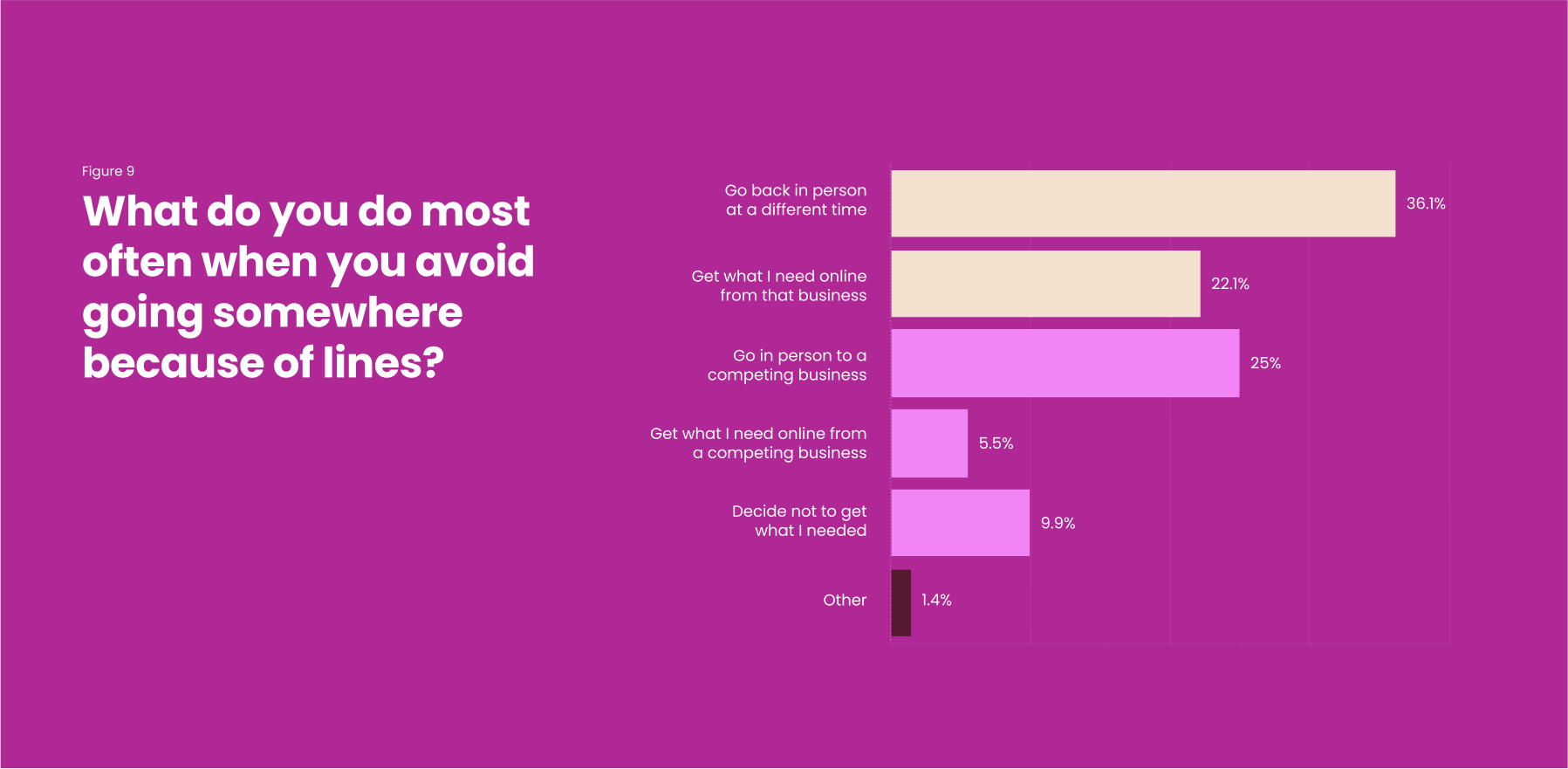
Of note for these consumers: only slightly more than half (58.2%) will return to that same business either in person or online to complete their purchase or service. More than 40% of these consumers will go to a competing business or give up shopping altogether to avoid lines (Figure 9).
Brand loyalty is clearly tied to the mere presence of physical queues, regardless of their length. If consumers associate a business with lines, they are less likely to return – or even come in the first place. Businesses with physical queues and a lack of alternatives for consumers like virtual queues or appointment scheduling options are not only hurting their bottom line, but also actively sending customers to competitors.
Part 3: Virtual Queues
57% of consumers prefer virtual queues
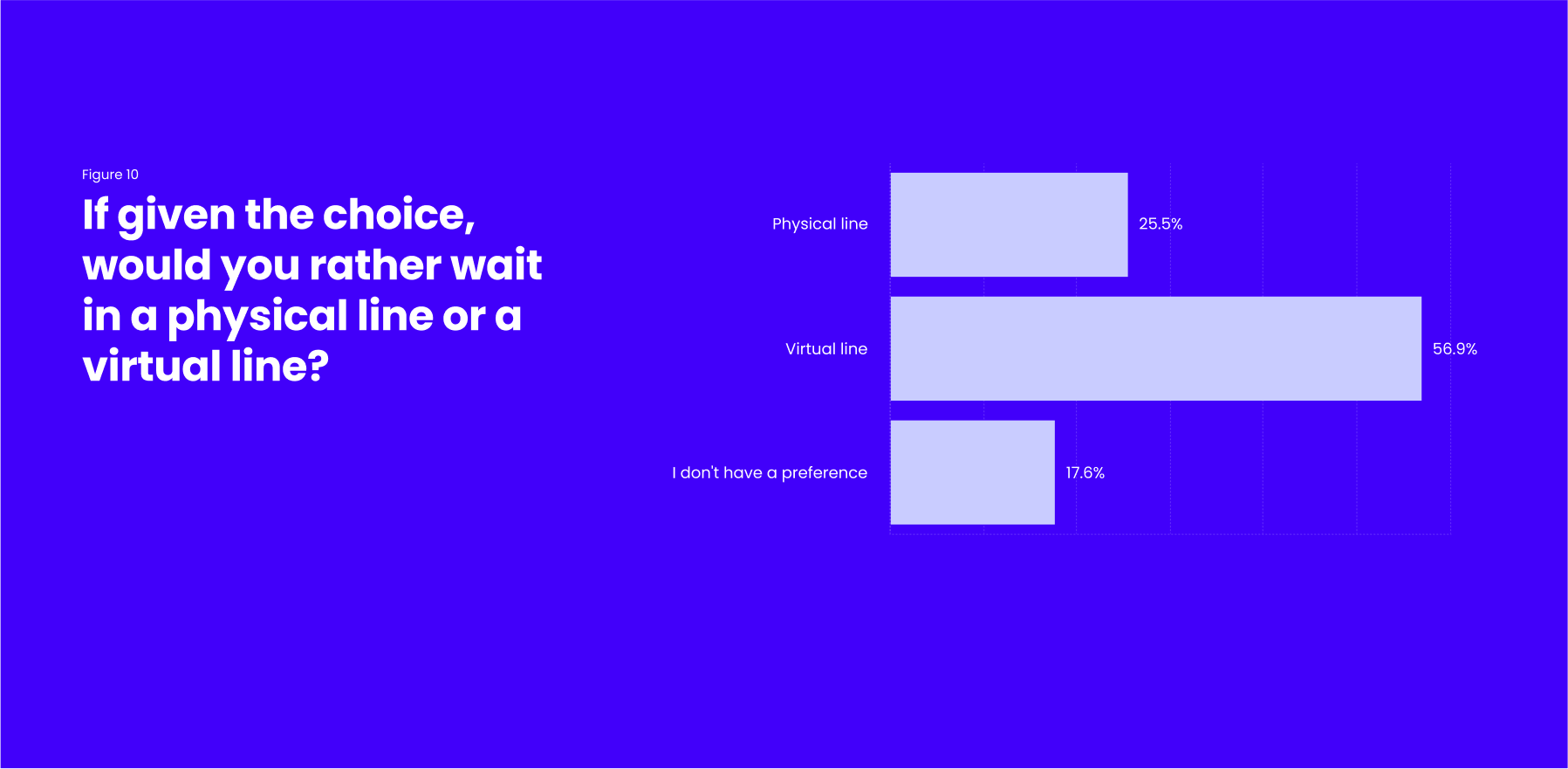
Since physical lines are so closely associated with negative business outcomes, businesses must work to implement alternatives, like virtual queues. A virtual queue allows a customer to see an accurate wait time, join a virtual waitlist with any device, and then wait from anywhere. During the wait period, customers receive consistent updates on their status and are able to do anything they like. This increased agency turns unproductive time (standing in a physical line) into occupied time, making the wait feel significantly shorter – or even eliminating the feeling of having to wait altogether.
This survey found that consumers much prefer virtual queues to physical lines. Virtual queues are 76% more popular than physical lines (Figure 10).
Related: What are Virtual Queues?

Even though there is a clear consumer preference for virtual queuing, the vast majority of businesses are still implementing archaic queuing practices. When asked about the last time they had to wait in line, more than 70% of the consumers surveyed said that they had to wait in a physical line (Figure 11).
On a positive note, we’re seeing incremental progress in the adoption of digital solutions that improve physical shopping experiences for consumers. Compared to last year, virtual queue presence was 11% higher (Figure 11). Still, consumers are too frequently faced with physical lines. Given the negative impacts physical lines have on both consumer sentiment and business outcomes, businesses need to move fast to implement virtual queuing solutions that improve the customer experience.
64% of consumers are willing to wait longer in a virtual queue

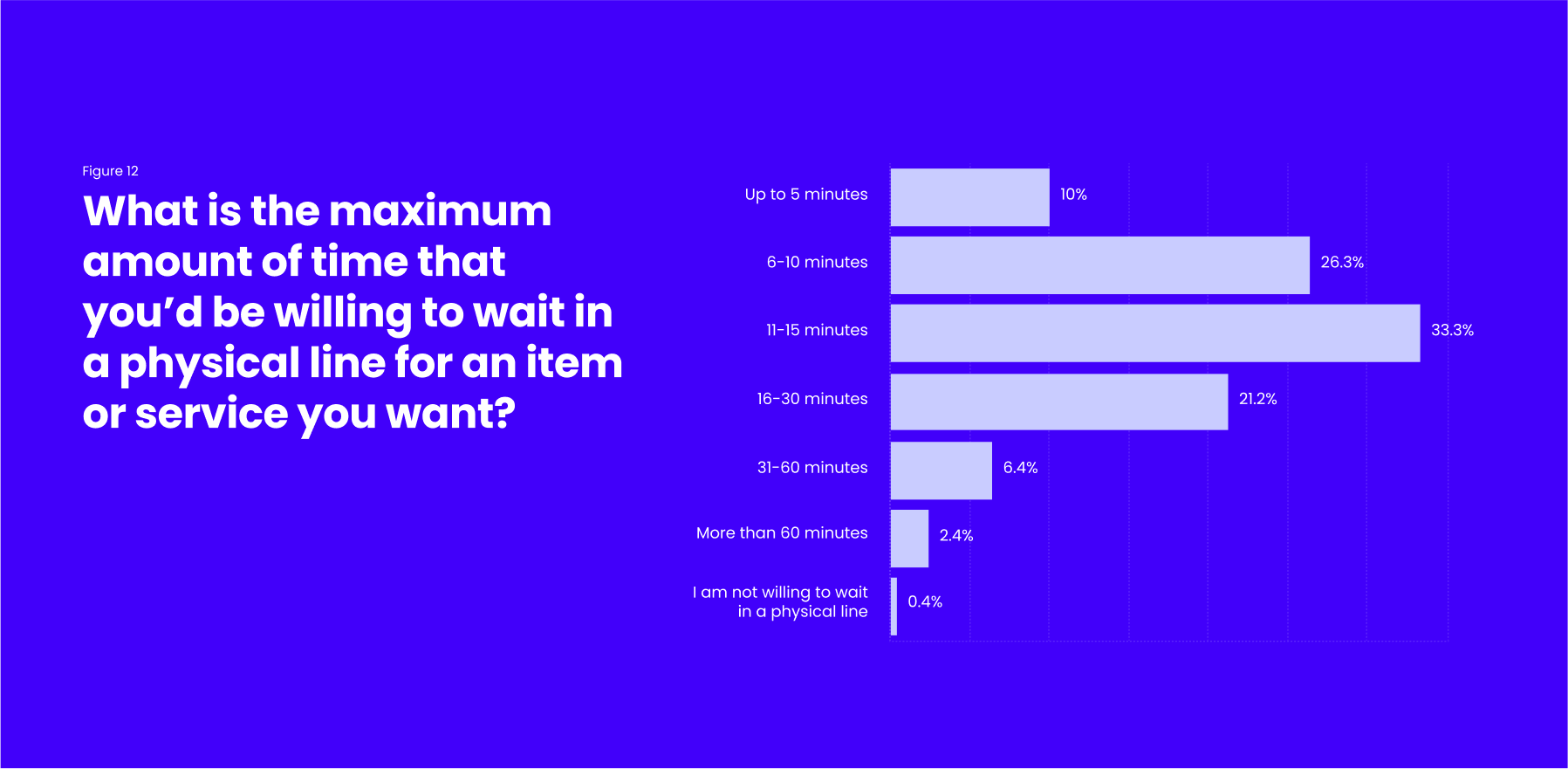
Virtual queues are not only preferred by consumers, but they're also associated with increased patience.
More than two-thirds of consumers are only willing to wait up to 15 minutes in a physical line for a product or service they want (Figure 12). Nearly the same amount of people are willing to wait longer in a virtual queue (Figure 13). 61% of these consumers are willing to wait more than 15 minutes longer in a virtual line; almost a third are willing to wait 30+ minutes longer (Figure 14).
Even as impatience has nearly doubled YoY (Figure 3), consumer tolerance for waiting via virtual queues has also increased by 6 pct. pts. (Figure 13).
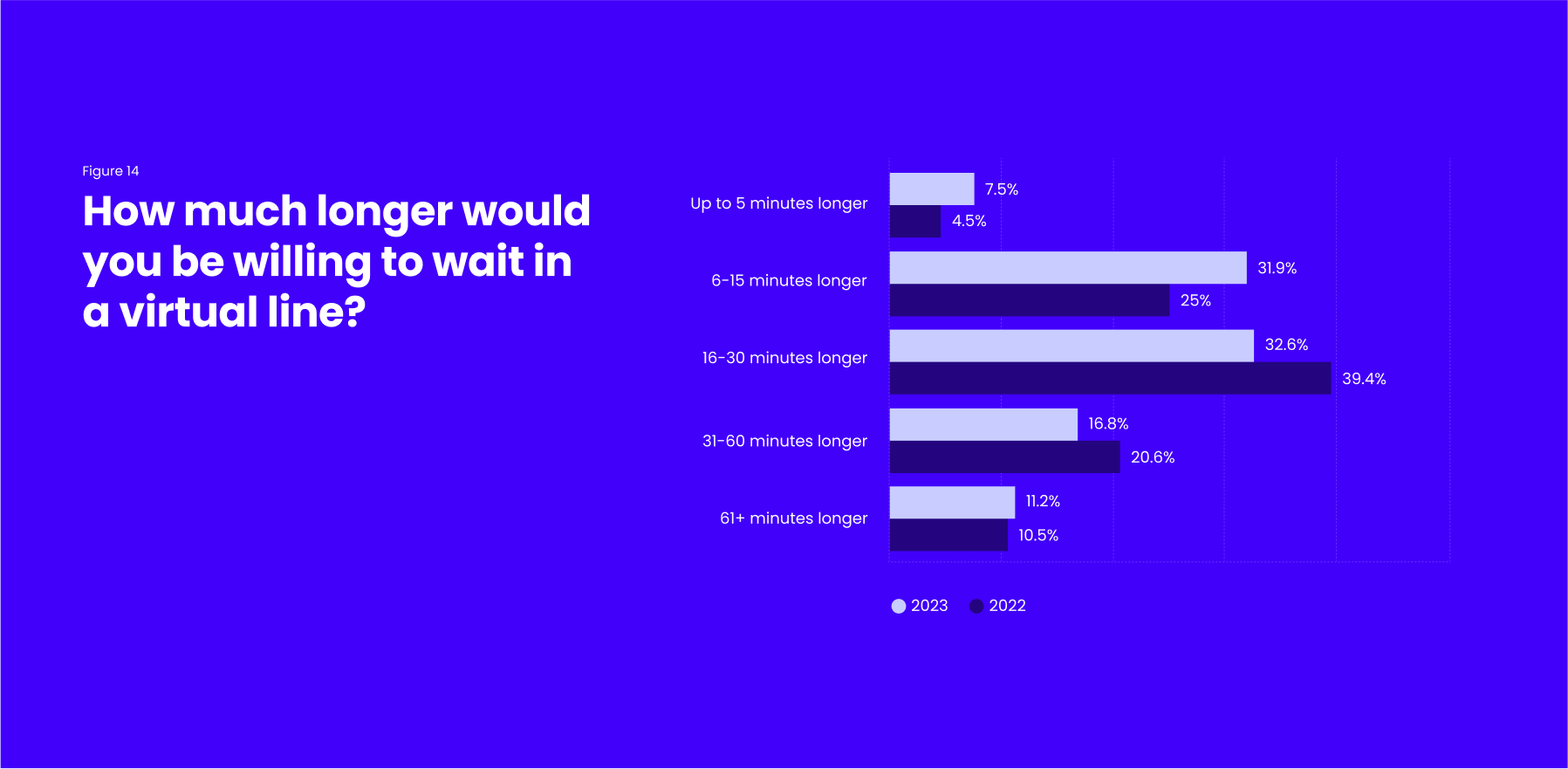
With consumer expectations for expedient service continuously growing, virtual queues will be critical in retaining business and making customers happy. Because waiting virtually gives consumers the freedom to do whatever they want, they’re willing to wait longer. This means that businesses looking to improve customer service need to make no other operational changes outside of implementing a virtual queue management solution (e.g., hiring more staff, increasing service capacity, expediting service, etc.).
38% of consumers will continue shopping while waiting in a virtual queue

Not only do virtual queues increase customer throughput and retention, but they could also drive sales. Almost 40% of consumers said that they would continue shopping or browsing at a business while queuing virtually.
A virtual queue system gives customers newfound agency and flexibility. Previously unoccupied time spent standing in line can be converted into productive time that, for many, translates into greater positive brand immersion. Businesses that implement virtual queues are not only likely to see increased store sales, but they also have an opportunity to create unique in-store experiences for consumers that can deepen their connection with your brand.
Keep Reading: Top Retail and Customer Experience Trends (2023)
Conclusion
This year’s edition of The State of Waiting in Line provides confirmation of last year’s core observations: waiting in line comes at a cost to both consumers and businesses.
For consumers, having to wait in line is associated with negative emotions like boredom, annoyance, frustration, and impatience. Consumers are eager for alternatives: 57% prefer virtual queues to physical lines and almost 70% would rather schedule an appointment.
Critically, this survey found that consumer impatience is skyrocketing. Compared to last year, consumers are 176% more impatient when it comes to physical queuing. This finding is unsurprising given our current social climate. Technology is increasing expectations for instant gratification while high levels of anxiety are shortening fuses.
According to The Conversation, “decreased patience and increased emotionality are real problems for service-based organizations and employees, along with the quiet quitting, ‘great resignation’ and ensuing shortage of talent they fuel.” Physical queues are burdening consumers, who are in turn straining the capacities of frontline workers. Having to deal with a greater rate of irritated customers, frontline staff have the “potential for burnout due to increased work demands.”
Related: Employee Sentiment Report: Retail
Outside of exacerbating staffing challenges, this survey also found that physical queues negatively impact business performance. More than two-thirds of consumers are only willing to wait up to 15 minutes in a physical line and 82% actively avoid going to a business because of lines. For these consumers, 40% will go to a competitor or give up shopping entirely.
The writing is on the wall: current approaches to queue management are unsustainable. Businesses must act quickly to eliminate lines and provide consumers with alternatives. Modern tech solutions that offer easy appointment scheduling and virtual queuing are a no brainer. These systems deliver on consumer expectations while bringing key efficiencies to business operations.
